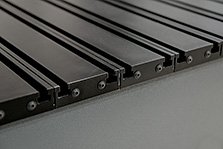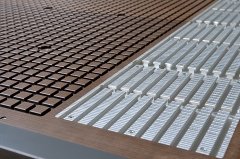Usually mounted horizontally under the machine gate. It can contain from a few to a dozen or so sockets for CNC tool holders. Tool change is faster than in linear magazines due to the shorter travel time to the tool change point.
Functionality that allows you to automatically change the tool used for machining (cutter, drill, head, etc.). The tool is placed in a special holder (cone), which is picked up by the machine spindle from the tool magazine (linear or rotary). Thanks to this solution, there is no need to stop machining and change the tool manually in the spindle.
High-quality cast iron rotary axis for CNC milling machines. It is suitable for processing steel, cast iron, aluminum and other non-ferrous metals, plastics as well as wood and other related materials. The control can take place in the indexed mode or with smooth simultaneous interpolation. The axle is available with a tailstock. Supplied as standard with a 125 mm diameter three-jaw chuck.
The touch scanning head is used, inter alia, to scan details in order to make duplicates or enter into the computer memory for further processing. It allows you to scan uneven surfaces and take into account its deflection when designing. It can also be used as a probe for basing on plates, in holes, on cylinders and for scanning three-dimensional objects for digitization. It is available in a wired version - manually mounted, lowered automatically on the Z axis and in a wireless version - taken from the tool magazine.
This head is characterized by a very high oscillation force. Thanks to this, it is possible to cut through materials that offer very high resistance, as well as materials with a large thickness. With the use of an appropriate blade, it is possible to cut rubber with a thickness of up to 30mm. The oscillation speed is regulated by setting the desired value from the program in the range from 0 to 5000 movements per minute. If the value is set to 0, the blade automatically moves to the maximum forward position and the head performs work without oscillation. A speed range of around 1000 strokes per minute is typically used.
System of minimum lubrication with air-oil mixture fed to the cutting zone. It replaces the traditional, uneconomical cooling systems of the treatment zone based on emulsion solutions. Before the outlet nozzle, the air supplied under pressure mixes with the oil dosed in the volume of a few drops per minute. Lubrication of the cutting zone...
A type of table used in Kimla milling machines. Made of an aluminum panel with inverted "T" grooves in which special nuts are placed, to which the mounting screws are screwed. In this way, you can attach vices, dedicated handles, as well as the material itself to the table.
A raster table made of HPL, on which the milled material (most often a plate) is placed and immobilized by means of a vacuum generated by a vacuum pump. Such a table has a number of grooves in which we can place a sealing profile and thus more accurately adjust the area of the suction to the format of the processed material.
The table is made of HPL, in the same way as the vacuum table, but with an additional section of T-groove panels. Thanks to this solution, we can fix the material on the same table using a vacuum, as well as mechanically.
A set of mechanical bases placed on the machine table, ensuring repeatability of the arrangement of the given material (usually boards). The operator, when placing the material on the table, pushes it against the protruding pins, thanks to which it is placed in the right place. This solution helps with high-volume production of components...









